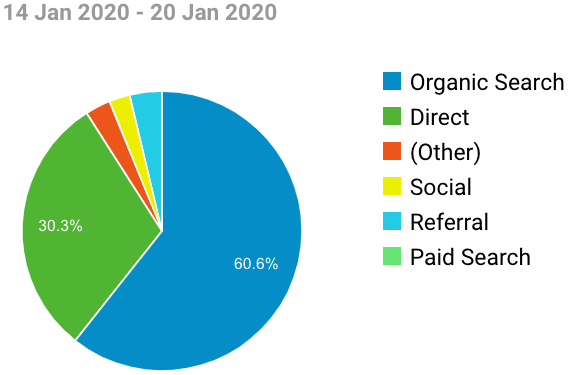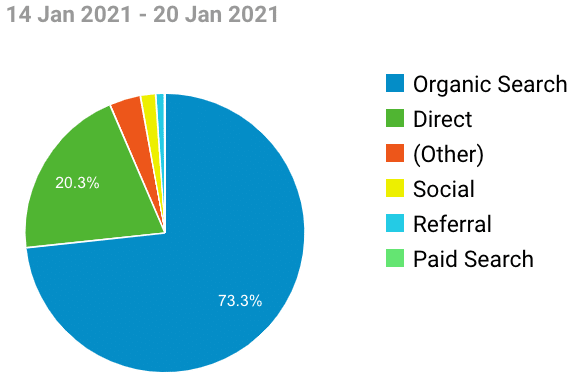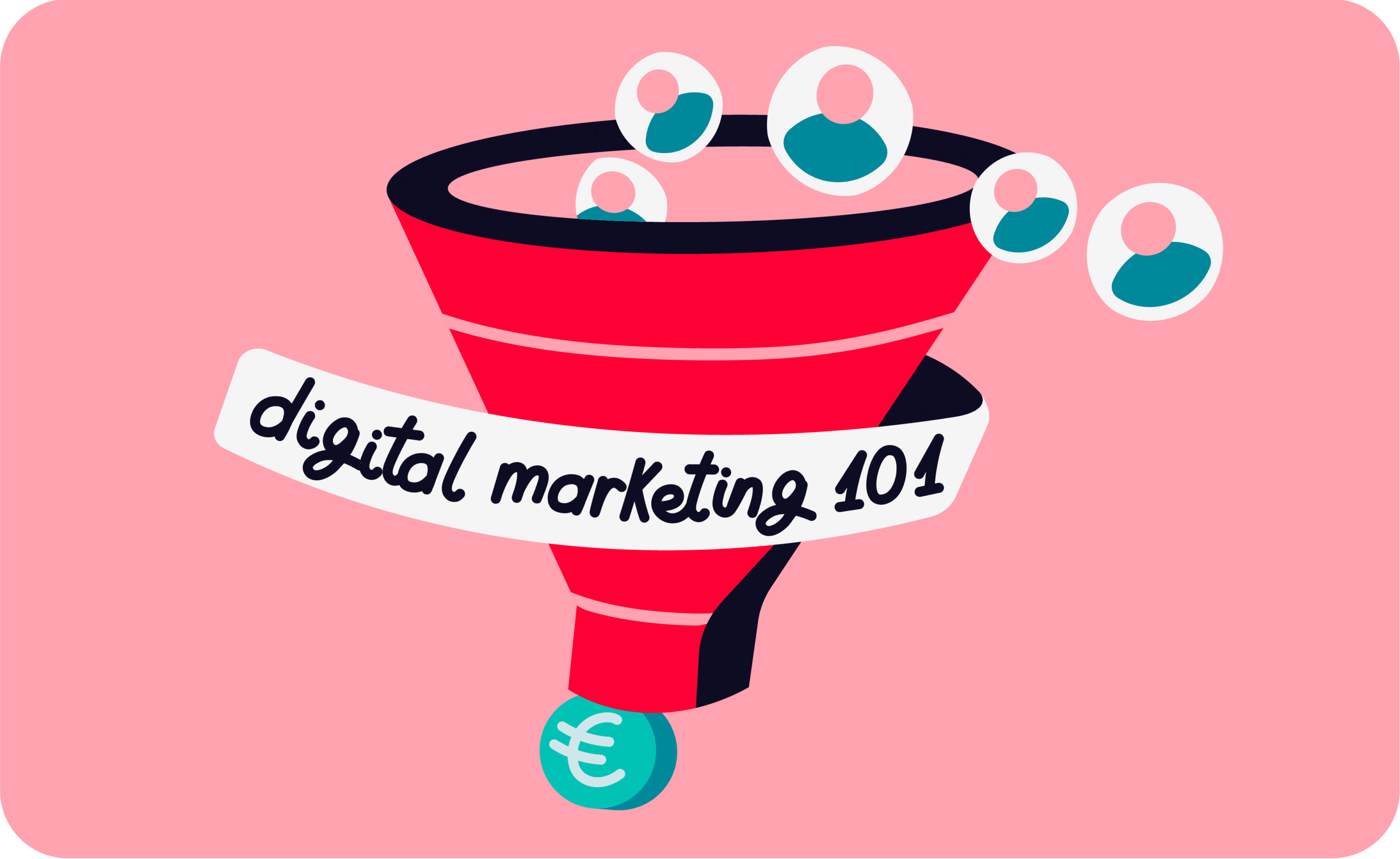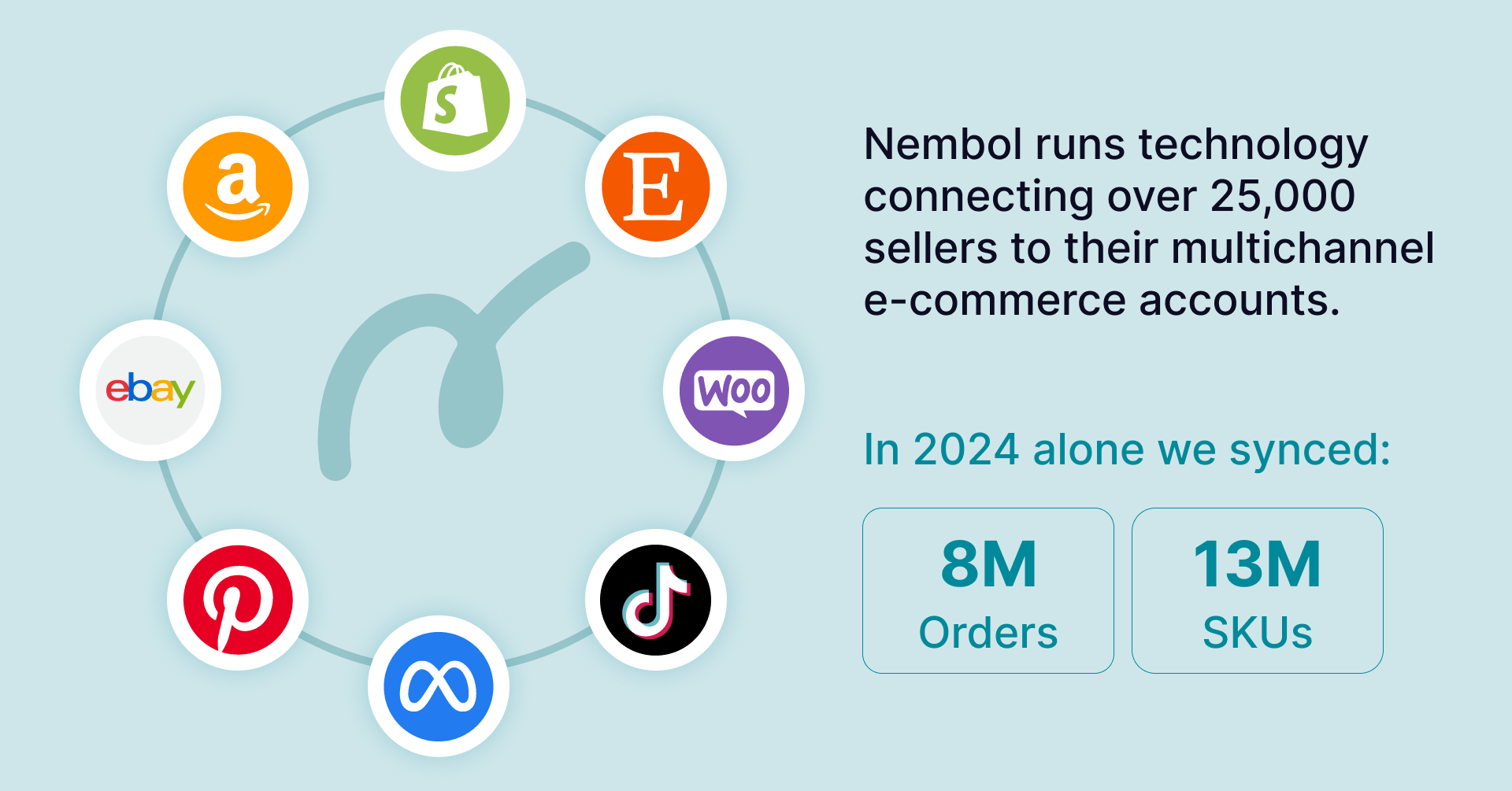Last update August 7, 2023
Overview
If we run an e-commerce website, selling either goods, or services, or software, the success of our sales will depend on the number of people visiting our Web property, our website.
As a general rule, a website will have numerous sources of traffic. The task of each online seller, will therefore be to:
- Measure such traffic
- Try to increase it constantly
- And convert it into orders
Different e-commerce traffic sources
Visitors, Visits, and Sessions
The people visiting our website will be called “Visitors”. And each visitor will generate “traffic”, “visits”, or “sessions”. See for example the pie-chart beside.


Six main sources of traffic
Here we can clearly see six main sources of traffic.
Since no traffic comes for free, the team of the website has to work constantly on improving the sources and attract new, relevant visitors.
We will see the results of one year of optimization at the bottom of this article.
How much does traffic cost?
Each traffic is different and has different costs. Let’s see sources one by one, starting from Google Analytics definition. Note that Google Analytics is a free tool and is the market-reference when it comes to measuring traffic on a Website.
Organic traffic
What is called by Google Analytics “Organic search” represents the number of visits (or visitors, upon your choice of metric) coming to our website by finding our pages on a Search Engine.
The cost of this traffic is the amount of time spent in generating and optimizing content (such as this very article you are reading) which will be indexed by search engines and potentially found by our future visitors.
Content writing and Search Engine Optimization (SEO) may employ several full-time workers in established companies. An SEO consultancy, ran by an established digital marketing agency, may cost between $10,000 and $20,000 to start with.
SEO and Content writing are therefore pretty much a fixed cost.
Direct traffic
Direct traffic represents:
- People that visited our website by typing its exact URL in the browser address field;
- People clicking on a direct link to our website, say in a browser bookmark, or in a Newsletter campaign, or in a pdf or MS Word document, or in a Mobile App.
Depending on the visitor’s browser settings also some Organic Search traffic may exceptionally be categorized as Direct. Excluding the exceptions, Direct traffic comes from our branding activity and from our Newsletter campaigns.
As for Content writing and SEO, companies focusing on online sales may employ several full-time employees running Newsletter campaigns or preparing off-line tutorial documents bearing links to our website. Also, Newsletters and Branding are a fixed cost.
Social
Social is traffic coming from sources that Google Analytics categorizes as Social Media. Typical examples are Facebook, Twitter, YouTube, Reddit, Instagram, LinkedIn, Pinterest, Tumblr, and so on. Often interaction between social media users and our website happens through a social media post.
Established companies have team-members, or suppliers, dedicated to “Social Media Management”. This means writing posts, as wells as re-launching content written by others that may be relevant for our brand.
If the transaction ultimately takes place on our own website, we need to have links from social media posts to our site. This is what Google Analytics measures. Therefore in most cases, Social Media management activity has a variable cost component: to have more traffic you need more posts and more activity on your Social media pages. Most social media websites offer paid advertising, which is often used as a complement to a good Social media presence.
Referral
Google Analytics tags as Referral traffic, all traffic coming from recognizable Web sources different from Social Media, Search Engines, or Paid campaign. If we have inbound links, from third-party sites, pointing to the URLs of our website, whenever some user clicked on them, this would be reported as Referral traffic.
Companies that are advanced in their Digital Marketing activity seek to have this type of inbound links either through direct negotiations or simply by producing very good content and therefore having other websites freely referring to them.
Paid traffic
Paid traffic reunites all traffic that Google Analytics recognizes as coming from a paid source. This is recognized automatically for Google Ads campaigns, but need the appropriate custom campaign parameters to be added to the ad’s destination URL if the paid source is other than Google Ads.
There is a variety of paid sources available to a marketer, and their cost, business model, and expected result on our traffic may differ sharply. We see them in the chapter below.
But first, let’s see the results of one year of work on traffic sources.
Results of one year of traffic optimization
Have a look at the pie-chart and spot the differences with the opening one.


The team considered that Organic traffic was the most desirable type of traffic, and therefore worked on new content, optimized content, and international presence. As a result, the pie-chart above shows a sharp increase in Organic traffic and a relative reduction of direct traffic. What can’t be spotted from the chart, is the sheer growth of overall traffic:
- Organic search: +319%
- Direct traffic: +132%
Therefore direct traffic grew sharply too in this business case, but its growth has simply been outpaced by the increase and success of Search Engine organic action. SEO.
Analysis of paid-traffic costs
Paid traffic can be purchased in a few standard ways, and this impacts on the mechanics of our business plan and expected returns. Let’s see them.
PPC – Pay Per Click (or Cost per Click)
We pay a fixed amount per click on our message, be it a text ad, a video, or an image banner.
- The amount is technically the “Cost per Click”, therefore these campaigns are dubbed indifferently PPC or CPC. Two important things to notice:
- The cost per click depends on several aspects including the time of the year, the time of the day, the industry, the keywords we are bidding on. Therefore each PPC campaign requires time and budget to be optimized. Enough time and enough budget. Given these two levers, the cost per click of a given PPC campaign can drop sharply.
Once the visitor has clicked, we still need to convert her or him into either a registered user or a paying customer. The need to convert generated a whole new branch of digital marketing activity called CRO – Conversion Rate Optimization. We will see below what exactly is the Conversion Rate and why it is important.
PPA or PPS – Pay per Action or Pay per Sale
In this case, we pay the source only if and when the client performs something more than a sheer click on our ad. Typically the action we want is a purchase, therefore we dub this “Pay per Sale”, but another meaningful action is leaving us an email address and the permission to be contacted later for marketing purposes.
The latter is another valuable Action, that many marketers feel has enough value to be paid for. PPS campaigns are run via specialized software tracking users and their interaction with the “cart” on our website.
PPV or PPI – Pay per View or Pay per Impression
A PPV campaign is charged by the sheer number of eyeballs seeing an ad, or a banner, or a logo, whatever the message that we want to deliver. In a Pay per View, or synonym Pay per Impression, we though pay a source just to be seen. Therefore this campaign may or may not be a source of traffic. It’ll be a source of traffic if some of the viewers of our message actually clicks on it.
The cost charged for a PPV campaign is often called CPM, or Cost per Mille. Being “Mille” Latin for one thousand. Despite the thousand in the name of the charge, often the unit of measure is not 1,000 views or impressions, but rather 10,000 views or impressions. Beware when you run your business plan.
Sources of traffic and type of charge
- Google Ads
Charges mainly PPC, some PPV on the network of third-party sites. - Facebook Ads
Charges both PPC and PPV. You can choose while setting up the campaign. - Most large media sites
Charge PPV mainly. This because they have limited inventory and do not take responsibility for the conversion of the message in a click and of a click in an Action. Also important: most media sites do not like their reader to click away and their pages and ads are structured accordingly. - Bloggers
Mostly charge by article or by inbound link. Unless part of a larger agreement.
How to draw a business plan based on traffic
Business plans based on PPC campaign
If we run a PPC campaign, the output will be clicks. Therefore we have to estimate how many of these clicks will turn into a paid order, and of what average order value:
Number of clicks received * estimated Conversion Rate = Number of orders
Number of orders received * Average order value = Expected revenues
Please check this article to understand how conversion rate works and how you can imporve it.
Business plans based on PPV campaign
When you run a Pay-per-View campaign, additionally you have to estimate how many viewers will click-through your banner to come on to your website. Consider that when your ad is seen by 10,000 people, a small minority of them will actually visit your website and therefore potentially become paying customers. PPV aka Pay per Impression campaigns are therefore very good for branding and less for selling. An example of business plan mechanics here would be:
Views * Click-through-rate = visits
Visits * Conversion rate = Number of orders
Once you have the number of orders, you multiply them by the average order value to obtain your revenues. Note that the Conversion Rate can be considerably different on different types of traffic.
Conversion Rate (CR) vs Click Through Rate (CTR)
CR and CTR are very different things:
What does conversion rate mean
The Conversion Rate is commonly defined as: Number of paid orders per number of visits. It is expressed as a percentage and ranges for e-commerce websites between 0.1% and 4%. It is the number of people actually buying from you and paying, out of those visiting you.
Conversion Rate is a widely used concept in e-commerce and it is often useful to devise intermediate conversion rates at need. For instance:
- CR1 = Registered users over a number of visits
- CR2 = Paid orders over registered users
How is the Click-Through Rate calculated
The click-through-rate is the number of people clicking on a link or a message out of all people seeing it.
It is an important rate in the Pay per Impression campaign and it is a metric shown by Google Ads to warn you on how many people actually saw your ad and, maybe, didn’t click. Always keep an eye on it, because if it goes too low, there is something wrong you are doing with your message or on your choice of advertising channel.


